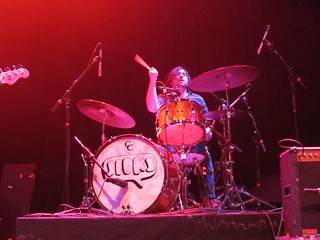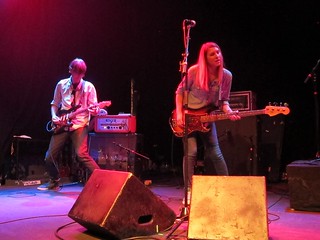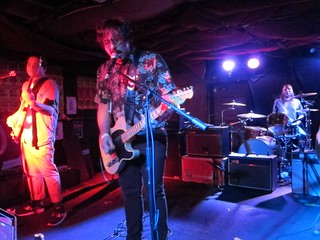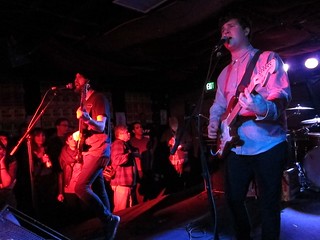Diffident emotion can't quite stick
2.5/5.0



 Humor me for a moment as I take us back to the early ‘90s and revisit alternative darlings Blind Melon. If it weren’t for 1993’s “No Rain” catching fire on MTV, they probably would have sunk without a trace, but that single pushed their eponymous debut album into everyone’s CD collection. I still have it myself and it’s a decent album. Personally, though, it hasn’t turned out to have true staying power. Maybe if lead singer Shannon Hoon hadn’t died of a drug overdose, they might expanded their sound and impact, but his voice -- plaintive and a bit self-absorbed -- is what anchored their songs, and that alone is just not enough to push it into my rotation anymore.
Humor me for a moment as I take us back to the early ‘90s and revisit alternative darlings Blind Melon. If it weren’t for 1993’s “No Rain” catching fire on MTV, they probably would have sunk without a trace, but that single pushed their eponymous debut album into everyone’s CD collection. I still have it myself and it’s a decent album. Personally, though, it hasn’t turned out to have true staying power. Maybe if lead singer Shannon Hoon hadn’t died of a drug overdose, they might expanded their sound and impact, but his voice -- plaintive and a bit self-absorbed -- is what anchored their songs, and that alone is just not enough to push it into my rotation anymore.The problem with Tree Machines’ debut EP is that it’s an indie pop version of Blind Melon, without the hyped single to pump it up. It’s easy to draw the comparison because Douglas Wooldridge’s disengaged whine seems to favor Hoon’s distinctive tone, but it’s also due to a similar songwriting style where the songs get wrapped up in themselves and shut out the rest of the world. Like Blind Melon, Tree Machines create some dreamy moments, but their songs don’t really connect, much less stick. Wooldridge imparts some emotion, but it’s delivered in an offhand, diffident way, lacking urgency or immediacy. As a result, these songs don’t make enough of a statement to rise above the already familiar sound.
"At the Wheel" is a perfect example, because it borrows from Blind Melon with a dram of Jane's Addiction thrown in for good measure. Wooldridge turns in one of his stronger emotional performances with lots of overwrought slurring and the arrangement is theatrical with thick reverb and cymbal wash accents. The hazy music and moody lyrics have a lot of potential; if they had accentuated the contrast between calmness and threat, this could have evoked a sense of sleep paralysis or a dream state of being powerless in the face of fate and trauma. The band shoots for this, with the words painting the shadowy part of the picture while the music remains almost idyllic, channeling a blend of The Youngbloods' "Get Together" and "If You Could Read My Mind" by Gordon Lightfoot. But any tension from the dark imagery is undercut as Wooldridge settles with, "It's dark out here / But I feel no fear at all." The swell of noise at the end is the best part, but it comes too late to add any real weight and I’m left wondering what the point was.
The best songs on Tree Machines come late in the playlist. "The Fire" summons more energy and features the most interesting arrangement here with a strong bass line and nice electronic touches in the background. The song also delivers some good dynamic swings, although the vocals blunt the power with dragged out syllables buried in echo. Still, if the whole album had been like this, it would have been something to get excited about. Similarly, "Black and Blue" effectively balances soft and loud sections to make a bigger impact, and it features more interesting instrumentation.
Even if Tree Machines is a bit of a disappointment, I’m not ready to write the band off yet. Those two peak moments suggest that they do have some more promising directions to explore.


 Bands don’t form in a vacuum; the best ones build on their inspirations and find their own signature voice.
Bands don’t form in a vacuum; the best ones build on their inspirations and find their own signature voice.  In the beginning was not the word, but a drone: a tone to form the backdrop for all the sounds that followed. Some of those later voices may vie for attention, assert their individuality against the cosmic hum, but eventually they surrender and rejoin its embrace. The Best Day is a celebration of that drone and the rich textures that surround it. While Sonic Youth long used feedback and resonance to build cathartic walls of ecstatic noise,
In the beginning was not the word, but a drone: a tone to form the backdrop for all the sounds that followed. Some of those later voices may vie for attention, assert their individuality against the cosmic hum, but eventually they surrender and rejoin its embrace. The Best Day is a celebration of that drone and the rich textures that surround it. While Sonic Youth long used feedback and resonance to build cathartic walls of ecstatic noise, .jpg) I may be a little out of touch – does ProTools have simple push-button production filters for classic sounds of the past? Instagram has settings for 1970s snapshots (1977) and washed out Polaroids (Earlybird), so it’s not that far-fetched to imagine virtual knobs for dialing in “1983 new wave” or “metal power ballad”. If it were that simple, it would explain why Cheatahs have saturated their sound with “late ‘80s British shoegaze”, maybe tempered with a light dusting of ”early ‘90s alt rock”. Their eponymous debut leads off with a brief flirtation with feedback that serves as a prelude to the first real song on the album, “
I may be a little out of touch – does ProTools have simple push-button production filters for classic sounds of the past? Instagram has settings for 1970s snapshots (1977) and washed out Polaroids (Earlybird), so it’s not that far-fetched to imagine virtual knobs for dialing in “1983 new wave” or “metal power ballad”. If it were that simple, it would explain why Cheatahs have saturated their sound with “late ‘80s British shoegaze”, maybe tempered with a light dusting of ”early ‘90s alt rock”. Their eponymous debut leads off with a brief flirtation with feedback that serves as a prelude to the first real song on the album, “ It’s a bittersweet pleasure to listen to Uncle Tupelo’s debut album No Depression with 24 years of hindsight. You can hear the band discovering themselves and developing their sound. It’s a snapshot from before the rancor set in. Their label, Rockville Records, hadn’t screwed them yet and the power struggle between Jay Farrar and Jeff Tweedy still lay ahead. Even though the acrimony and split would lead to Farrar’s Son Volt and Tweedy’s Wilco, each of which have made some great music, it’s painful to listen to the band bare themselves in these raw songs and think of what would follow. Their simple sincerity and naïveté made this big impact that the band itself could not outlast and their debut remains fresh and relevant. No Depression captures the beginning of a groundswell that had its roots in the cow punk sounds of X, the Blasters and the Beat Farmers. Tempered by firmer leanings toward folk rock and country, this album has been largely credited with spawning a new genre that never came up with a good enough name; alt-country, Americana or the eponymous “No Depression” have all sat in as labels, but none quite satisfy. Less than a name, it all comes down to the music and attitude.
It’s a bittersweet pleasure to listen to Uncle Tupelo’s debut album No Depression with 24 years of hindsight. You can hear the band discovering themselves and developing their sound. It’s a snapshot from before the rancor set in. Their label, Rockville Records, hadn’t screwed them yet and the power struggle between Jay Farrar and Jeff Tweedy still lay ahead. Even though the acrimony and split would lead to Farrar’s Son Volt and Tweedy’s Wilco, each of which have made some great music, it’s painful to listen to the band bare themselves in these raw songs and think of what would follow. Their simple sincerity and naïveté made this big impact that the band itself could not outlast and their debut remains fresh and relevant. No Depression captures the beginning of a groundswell that had its roots in the cow punk sounds of X, the Blasters and the Beat Farmers. Tempered by firmer leanings toward folk rock and country, this album has been largely credited with spawning a new genre that never came up with a good enough name; alt-country, Americana or the eponymous “No Depression” have all sat in as labels, but none quite satisfy. Less than a name, it all comes down to the music and attitude.



















 As the famous phrase goes, some men just want to watch the world burn, not necessarily out of malevolence, but sometimes because they never let themselves hope for anything more. On
As the famous phrase goes, some men just want to watch the world burn, not necessarily out of malevolence, but sometimes because they never let themselves hope for anything more. On  More than 20 years ago, Liz Phair drifted into Chicago’s indie scene and tried to find her place. Surrounded by bands like Smashing Pumpkins, Urge Overkill and Codeine, Phair shopped her home-made “Girly Sound” cassettes and built up some hype. After a failed attempt to develop her demos with John Henderson’s label, Feel Good All Over, she connected with Matador Records in 1992 and moved forward on what would become Exile in Guyville. The title referenced an Urge Overkill song, “Goodbye to Guyville” and reflected some of Phair’s distance from the testosterone heavy scene. But Phair borrowed that masculine energy to move beyond the classic female singer/songwriter trope. Her tight guitar hooks and catchy lyrics exuded rock credibility and she offered plenty of brazen words and hard looks. But even as she played the rocker role, she couldn’t bring herself to treat the songs shallowly. She wrote too truthfully and her vulnerability leaked past the sarcasm and defiant facade. From the opening song, she blended softness with a harder edge and set the stage for the whole album.
More than 20 years ago, Liz Phair drifted into Chicago’s indie scene and tried to find her place. Surrounded by bands like Smashing Pumpkins, Urge Overkill and Codeine, Phair shopped her home-made “Girly Sound” cassettes and built up some hype. After a failed attempt to develop her demos with John Henderson’s label, Feel Good All Over, she connected with Matador Records in 1992 and moved forward on what would become Exile in Guyville. The title referenced an Urge Overkill song, “Goodbye to Guyville” and reflected some of Phair’s distance from the testosterone heavy scene. But Phair borrowed that masculine energy to move beyond the classic female singer/songwriter trope. Her tight guitar hooks and catchy lyrics exuded rock credibility and she offered plenty of brazen words and hard looks. But even as she played the rocker role, she couldn’t bring herself to treat the songs shallowly. She wrote too truthfully and her vulnerability leaked past the sarcasm and defiant facade. From the opening song, she blended softness with a harder edge and set the stage for the whole album.

 Barcelona rockers
Barcelona rockers 


 If there's a brief summary for the characters in
If there's a brief summary for the characters in 
